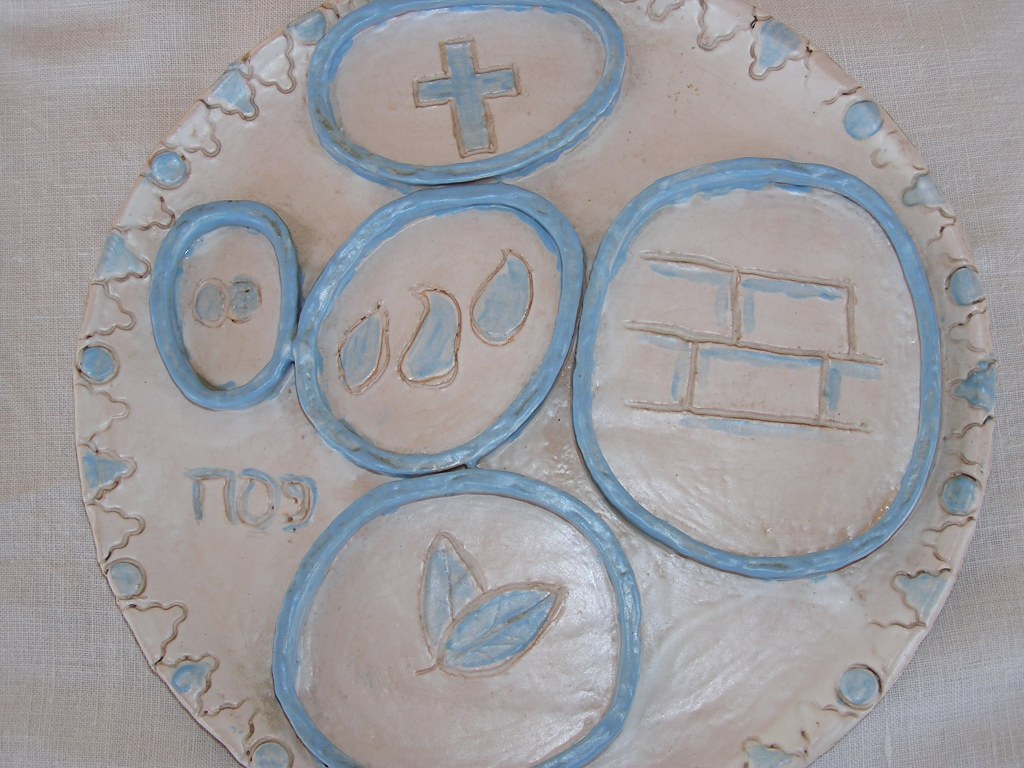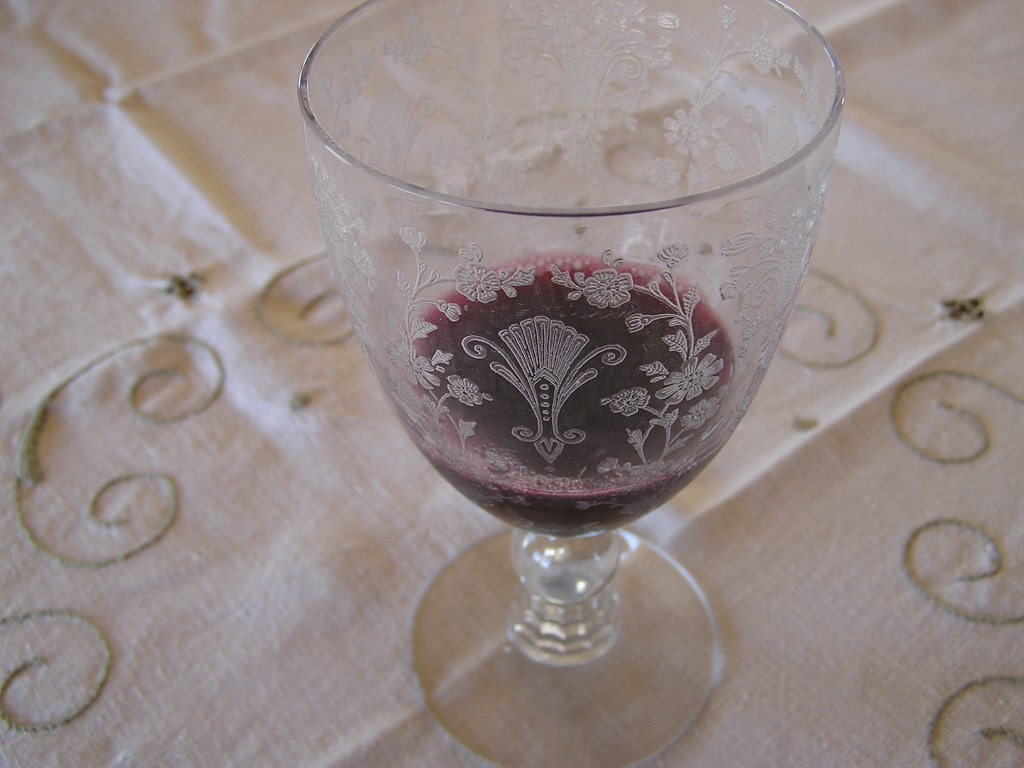
We began annual Passover/Seder meals many years before our daughters were born with two friends we had known since high school. One of the most memorable ones was the year Diane, the wife of this couple was 7 months pregnant with triplet boys. Their two-year old girl, Anna, was at this celebration as well. Diane was very uncomfortable so we kept the menu fairly simple and took the evening slowly with many breaks.
Passover is important to Christians in two ways. First it celebrates the story of the rescue of Israel from slavery and second it is the occasion of the Last Supper. For our order of service we follow a ceremony used by conservative Jews, except for the place where the communion bread and cup occur. At that time we insert a communion service.
This full evening event will include symbolic foods, Passover story telling, a fancy meal, singing, Hebrew blessings, and more. Here is an abbreviated service to create you own.
Christians often celebrate on the Thursday before Easter.

Materials:
- Plate with the following foods arranged on it: Hard-boiled egg. Parsley, cooked bone, horseradish, Haroset, (Combine ground- up apples, ground-up nuts, and cinnamon/sugar. Looks ugly, tastes great.)
- Small dish of salted water.
- Glass of juice for everyone.
- Plate with three Matzah or crackers
- Napkins (2 for each person) and plates for everyone.
- Small bowls of finger washing water for everyone.
- Two candles in holders.
- The leader will need a little coin money
The Ceremony
- Hide some pieces of regular raised bread around the room. The kids must find these and throw them out of the house (now bird-food) before you can begin. This is the Feast of Unleavened Bread and no leavened bread should be in the room.
- Sit at the table. Light two candles saying, “Blessed art Thou, O Lord our God, King of the Universe creator of the radiance of fire.”
- Leader says a blessing. “Blessed art Thou, O Lord our God, King of the Universe who has kept us alive and brought us to this day.”
- All take the first sip from your juice glass.
- Leader introduces Ceremonial foods:
“This bone reminds us of the Passover lamb who was slain.
This horseradish reminds us of the bitterness of slavery in Egypt.
This haroset reminds us of the brick mortar we worked with when we were building for Pharaoh.
This egg reminds us of new life and resurrection.
This parsley reminds us of joy.
This salt water reminds us of the tears shed by the Israelites during their years of enslavement.
These three Matzahs remind us of unleavened, flat bread the People of Israel ate as they hurried to leave Egypt.”
- All wash fingers in your water bowls.
- Leader blesses parsley, “Blessed art Thou, O Lord our God, King of the Universe creator of the fruits of the earth.”
- All take a piece of parsley, dip it in the saltwater and eat.
- Leader takes middle Matzah, breaks it in half and wraps it in a napkin or cloth. (At some point the leader will secretly hide this Matzah somewhere in the room. If you include a full meal the leader can easily do it as people eat, if no meal is included the leader may choose to hide it in another room or ask everyone to close their eyes while it is being hidden.) No explanation is given at this time as to why the Matzah is being broken and wrapped up.
- Telling of the Passover story.
- The storyteller of you group now has the floor to tell the story of the Passover. The story can begin with the birth of Moses or the burning bush. The story must go at least as far as the Passover, but may go as far as the Red Sea if you wish. The story is told in Exodus 1-14. When the plagues are related every one has the job of pouring out 1 drop of their juice into their napkin on their plate (not easy). “This reminds us of the bitterness of each plague because our sweet drink is decreased.” The story teller is invited to have fun and add humor.
- All take a second sip from their glass.
- All wash fingers and dry with fresh napkin.
- Leader blesses bread: “Blessed art Thou O Lord our God, King of the Universe who brings forth bread from the earth and has commanded us to eat unleavened bread”
- All take a small piece of bread and eat it.
- All take a bit of Haroset and eat it.
- Leader blesses the bitter herb (horseradish), “Blessed art Thou O Lord our God, King of the Universe who has sanctified us with thy commandments and commanded us to eat bitter herbs. ”
- All take a taste of horseradish. (This is challenging for many kids, some use a piece of Matzah to help and keep it very small.)
- Hillel Sandwich: Hillel, a rabbi around the days of Jesus, began a custom of eating bitter herbs with haroset and Matzah. So make a Hillel sandwich and enjoy. This has become the quintessential taste of Passover for my family.
- All take a piece of hard boiled egg, dip it in salt-water and eat. This symbolizes mourning and resurrection.
- If you are eating a full meal this is the time when you serve and eat. If not then eat the rest of the ceremonial food except save some juice.
- Finding and redeeming of the middle Matzah. Before the ceremony can continue the Middle Matzah, called the afikomen, must be redeemed. Children are now invited to search for the buried/hidden Matzah. When it is found the finder sells it back to the leader for some coins. Some kids sell quickly for a small sum while others hold out for a greater reward. When the leader succeeds in buying back the Matzah the ceremony can continue.
- Leader explains: “The breaking, burying, and bringing back of the middle Matzah is an ancient part of the Passover ceremony. Many Christians today see it as a symbol of Jesus. The Bread of Life who was broken on the cross, buried, and then brought back to life.”
- Leader explains:“When Jesus had the first communion with His disciples it was at a Passover meal. This is now the part of the meal when He might have offered the broken bread and cup to His friends.”

Two Choices
First Choice
If you are from a tradition where you are free to have a family communion service this is the place in the ceremony where you would do it using your juice and redeemed middle Matzah.
Or proceed with the following.
Second Choice
- Leader blesses bread (redeemed middle Matzah): “Blessed art Thou O Lord our God, King of the Universe who brings forth bread from the earth.”
- All take a piece of the bread and eat.
- Leader blesses juice:“Blessed art Thou O Lord our God, King of the Universe who created the fruit of the vine.”
- All take a drink from their juice glass. Ceremony continues after first and second choice with the following.
- Leader gives grace after meal;“Blessed art Thou O Lord our God, King of the Universe who feeds the whole world with thy goodness, and with grace, kindness, and mercy gives food to every creature, for thy mercy endures forever.”
- All drink the final drink of juice.
- Read Psalm 136. One reader reads the first part of each verse and everyone else responds with the second part, “for His steadfast love endures forever”.
An excerpt from my curriculum: Intentional Fun: Tools for Pursuing Faith With Children